In today's society, everyone is inseparable from a variety of electronic devices, especially mobile phones and computers, all kinds of videos, patterns and text in the devices are displayed through electronic screens, and thedisplay equipment of these electronic products is liquid crystal. What is liquid crystal? How does it display numbers or images? Then let's understand the internal structure of the screen in detail and understand the principle.
I order to know the display principle of the screen, we also have to start from the following understanding
What is liquid crystal
Let's start with the three states of matter commonly found in nature - solid, liquid and gas. Under normal circumstances, the reason why substances present three states can b
e understood from the microstructure, such as the solid we see, such as salt crystals, has a certain shape and volume.

Crystal atomic structure
Because its molecules are arranged tightly and neatly according to inherent rules in a specific direction, the equilibrium position is relatively fixed, can only vibrate in a small range, and anisotropy; Liquid such as water, its intermolecular distance is large, the equilibrium position changes at any time, the range of activity is wide, the molecular orientation is not regular, macroscopic performance is not a certain shape, but a certain volume, with fluidity; Gas has neither a certain shape nor a certain volume, and its molecules can move freely.
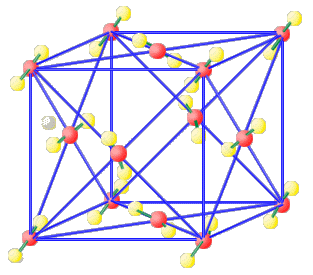
Flowing liquid
There are also things in the physical world that are somewhere between solid and liquid. It's the liquid crystal. At the end of the 19th century, Austrian botanist Reinitzer studied a kind of organic matter called "cholesteryl benzoate" and found that when it was heated to 145.5℃, it melted into a cloudy liquid, and suddenly became a transparent liquid at 178.5℃ When cooled, it appears bluish-purple, which soon disappears on its own, presents a cloudy liquid again, continues to cool, appears bluish-purple again, and then solidifies into a white crystal. Faced with this phenomenon, Reinitzer could not explain it, so he sent samples and observations to the German physicist Lehrmann. Lerman believed that this was a flowing crystal, and gave this form of matter the name "liquid crystal". Thousands of organic compounds have been found to have liquid crystal states, which are intermediate states between solid and liquid. Compared with the liquid molecular model, the liquid crystal molecules have no position order, but have orientation order, that is, the molecular orientation is very consistent
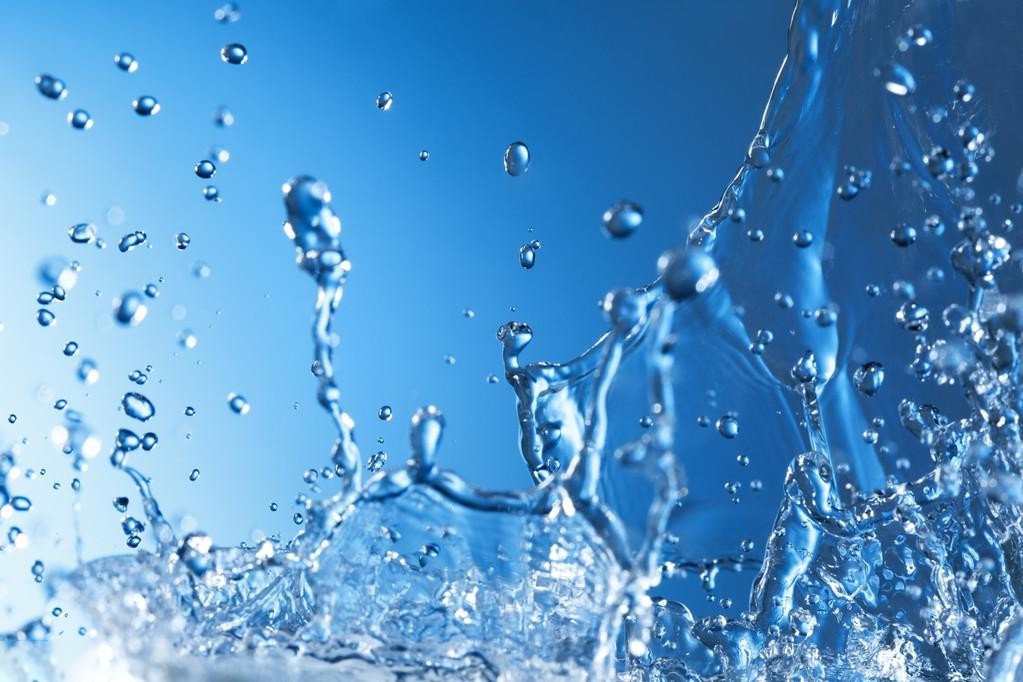
Flowing liquid
There are also things in the physical world that are somewhere between solid and liquid. It's the liquid crystal. At the end of the 19th century, Austrian botanist Reinitzer studied a kind of organic matter called "cholesteryl benzoate" and found that when it was heated to 145.5℃, it melted into a cloudy liquid, and suddenly became a transparent liquid at 178.5℃ When cooled, it appears bluish-purple, which soon disappears on its own, presents a cloudy liquid again, continues to cool, appears bluish-purple again, and then solidifies into a white crystal. Faced with this phenomenon, Reinitzer could not explain it, so he sent samples and observations to the German physicist Lehrmann. Lerman believed that this was a flowing crystal, and gave this form of matter the name "liquid crystal". Thousands of organic compounds have been found to have liquid crystal states, which are intermediate states between solid and liquid. Compared with the liquid molecular model, the liquid crystal molecules have no position order, but have orientation order, that is, the molecular orientation is very consistent

Molecular structure of different substance states
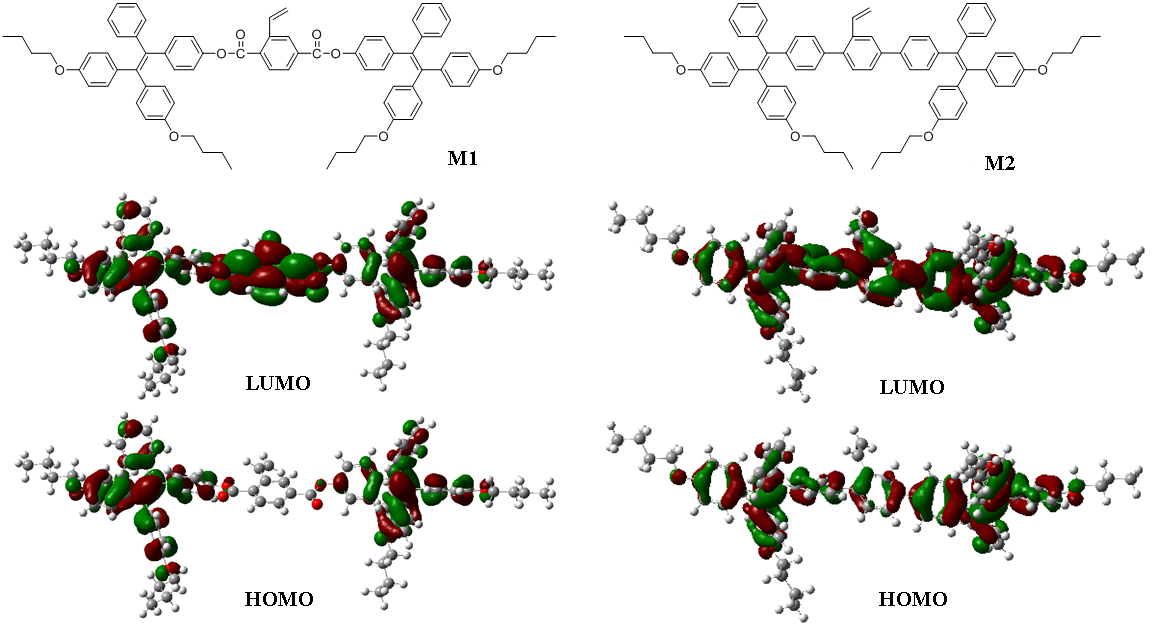
Several liquid crystal molecular structures
In summary, the so-called liquid crystal refers to a class of substances whose shape is like a liquid, and whose microstructure and optical properties are completely similar to crystals. So how does it work in a display?
Let's start with the simple application
It has been found that liquid crystals have many properties and effects, such as electro-optical effect, thermo-optical effect, photoelectric effect, ultrasonic effect and physical and chemical effects, such as liquid crystal displays mainly use the electro-optical effect of liquid crystal. The following describes how liquid crystal plays a role in the display screen, first of all, the liquid crystal must be installed in the liquid crystal box composed of glass

Liquid crystal box and internal crystal
Above is the structure diagram of the liquid crystal box. Two standard flat glass plates with excellent parallel planes are called glass plates. The outside of the upper and lower glass plate is equipped with a polarization film, or polarizer, the role of the polarizer is to pass the light wave parallel to the direction of the polarizer, and only the light wave vibration direction is consistent with the slit of the polarizer can pass, so the light wave with various orientations in the light source can be filtered into a single orientation of the light wave. Since the upper and lower polarizers are perpendicular to each other, the light waves passing through the first polarizer need to rotate 90º to pass through the second polarizer, so it is time for the liquid crystal to play its optical rotation role, by adding different electric fields to the upper and lower sides of the liquid crystal to change the behavior of the internal liquid crystal. In order to add an electric field to the liquid crystal, the tin dioxide transparent electrode is installed on the inner surface of the glass plate, the shape of the electrode can be designed into various shapes according to the needs of the display, in order to make the liquid crystal molecules can be continuously twisted into 90°, the inner surface of the liquid crystal box is arranged along the surface, so that a liquid crystal box is completed. Finally, the liquid crystal box is filled with a liquid crystal that adds optical substances, and then the liquid crystal box is glued with a rubber frame around it, and the liquid crystal box becomes a liquid crystal display. Because the liquid crystal molecules inside are optically active, the direction of the light wave passing through the polarized light can be rotated 90º, and then through the lower polarizer, so we can see the bright background. When we apply an electric field to both sides of the liquid crystal, under the action of the electric field, the liquid crystal eliminates the original distorted state, and the liquid crystal molecules are arranged in an orderly plane, perpendicular to the upper and lower electrode surfaces. The vibration direction of the incident polarized light remains unchanged when passing through the liquid crystal, that is, the vibration direction of the incident light is perpendicular to the polarization direction of the lower polarizer, the incident light will be absorbed, so no light is reflected back, and you can not see the reflective plate, so the electrode position is dark, and the situation without electric field is exactly the opposite.
In the actual use of black and white liquid crystal, seven-segment digital display is commonly used, as shown in the figure.
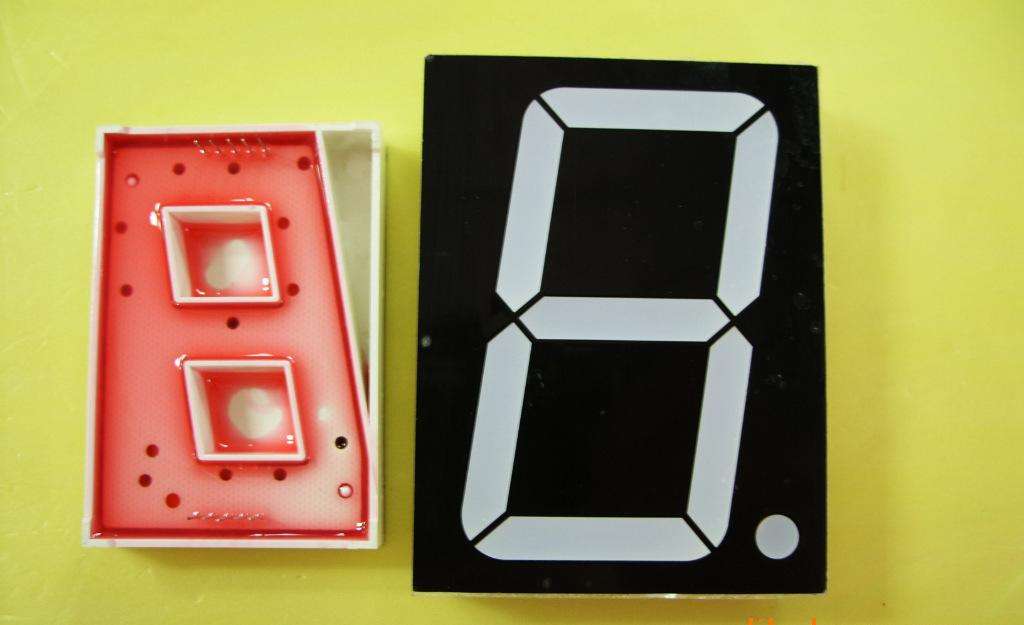
Seven segment digital display
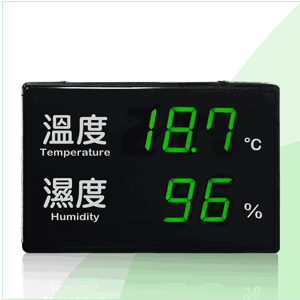
Change the digital display
The stroke of the number is composed of seven transparent electrodes separated from each other, and each electrode is connected with the decoding circuit, so that the state of the decoding circuit can be digitally displayed through the seven-segment display with the Arabic transparent electrode lead.
The display mode has positive display and negative display. When a certain voltage is added between the electrodes, the voltage of the several sections will become dark, so as to show a group of numbers with black letters on a white background, this display is called the positive display, usually used LCD electronic watches, pocket calculators are positive display type digital display. If the polarization directions of the two polarizers are parallel, the incident light is absorbed when no voltage is applied, and we get a black background. When a voltage is added to the electrode that needs to display the number, the polarized light can pass through the liquid crystal and be reflected back, so we can see that the white number is presented on a black background, forming a negative display type digital display with white words on a black background. Similarly, according to actual needs, delicately produced a variety of electrodes, but also to achieve the text, symbols and images of the liquid crystal display.
Liquid crystal dynamic black and white dynamic display principle
Dynamic display usually adopts the dot-matrix display mode. The electrodes are made into parallel shapes, and the electrodes of the upper glass plate and the electrodes of the lower glass plate are formed into three-dimensional orthogonal structures. The parts that cross each other are dot matrix elements, represented by small squares in the figure. When the number of electrodes in the x direction and the number of electrodes in the y direction are both n, n² pixels can be formed with 2n electrodes. When the area of the pixel is smaller, the more the number of units in the area, the more delicate the image is displayed.
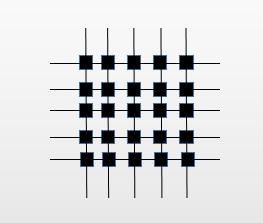
Liquid crystal pixel
When the electrodes in the x direction are scanned from top to bottom in chronological order, and the electrodes in the y direction are scanned according to the display signal plus selected and non-selected signals, then all strobes are bright and the rest are dark. Because the scanning speed of the X-direction electrode is very fast, the strobe point will constantly change, and because the time interval is very small, the visual pause can make the observer see a complete picture. The process of progressive scanning is very similar to the line scanning process of the cathode-ray picture tube, when the electrode in the x direction is scanned from top to bottom, complete a frame of continuous scanning, and at the same time add selected or non-selected signals to the column electrode to realize the display function of all pixels. If during the N-frame scan completed by the row electrode, the column electrode continuously repeats the selected signal waveform during each frame, a static picture can be obtained on the display screen. If the selection signal waveform of the column electrode varies from frame to frame, a dynamic picture is formed. A quick scan of the electrodes shows a gorgeous black-and-white animation

Dynamic black and white display photos
The above is the display principle of black and white liquid crystal display, the use of liquid crystal rotation to control whether the light through to change the light and dark to form a pattern.
Color LCD screen display principle
The principle of color liquid crystal display is similar to that of black and white display, but the structure is slightly changed, the control circuit is increased, there are more pixels, each pixel is independently controlled by a transistor. The light source used in color displays is generally placed inside the screen, and the light source passes through the liquid crystal from inside to outside to form a bright pattern.
Below we will briefly explain the structure and display principle of TFT-LCD LCD screen.
TFT - The structure of the LCD LCD screen
Tft-lcd LCD screen is mainly composed of backlight, polarizer, transparent electrode (control circuit), liquid crystal, color filter and polarizer from the inside out.
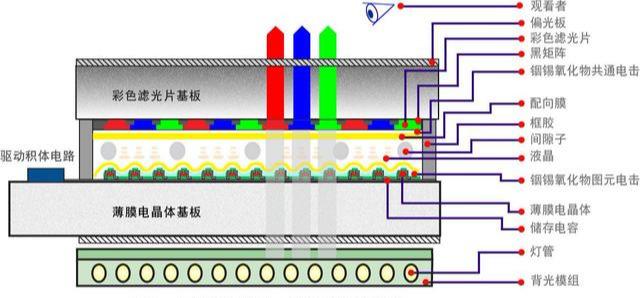
LCD display structure
Optical effects of liquid crystals
The liquid crystal is contained in the middle of two trough surfaces, and the direction of the trough is perpendicular to each other, as shown in the following figure, the polarization direction of the upper and lower surface polarizer is perpendicular to each other, the arrangement of liquid crystal molecules is: the upper surface is longitudinal, the lower surface is transverse, and the molecules in the middle of the upper and lower surfaces produce rotation effect, so the liquid crystal molecules produce 90º rotation between the two trough surfaces.
When linearly polarized light is injected into the upper slot surface, the light also rotates with the rotation of liquid crystal molecules. When linearly polarized light exits the lower trussed surface, this light has produced a rotation of 90º. When a voltage is applied between the upper and lower surfaces, the liquid crystal molecules will line up in the direction of the electric field, forming an upright arrangement. At this time, the incident light is not affected by the liquid crystal molecules, and the straight line cannot be emitted from the lower surface. Different voltage values determine the Angle of liquid crystal deflection.
Then the screen is generally an internal LED as a light source, emitting white light, then we know that white light is a combination of a variety of different frequency light waves. Then we can get the color we want through the filter. Although there is a certain range of wavelengths of visible light for each color, we do not need to represent each wavelength separately when dealing with color. Because all the colors in nature can be obtained with different intensities of the three color wavelengths of red, green, and blue (RGB), this is often referred to as the principle of three primary colors. Therefore, these three kinds of light are often called the three primary colors or three primary colors. These three colors are filtered through the filter membrane, and then the Angle of liquid crystal turnover is adjusted by changing the driving voltage, and then the light amount through the RGB sub-pixel is changed, and the rich color performance is obtained by the principle of addition color mixing.
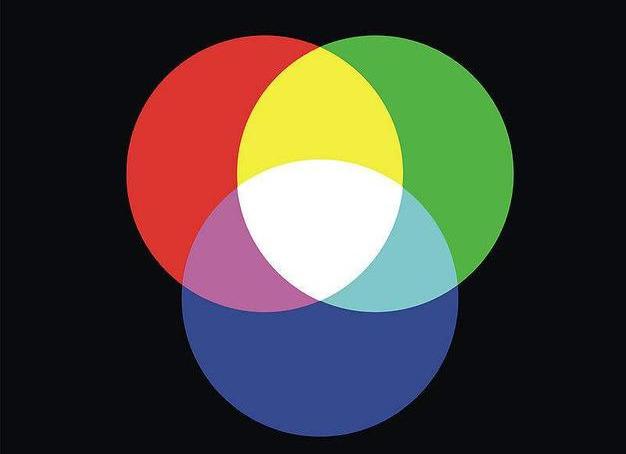
RGB three primary colors
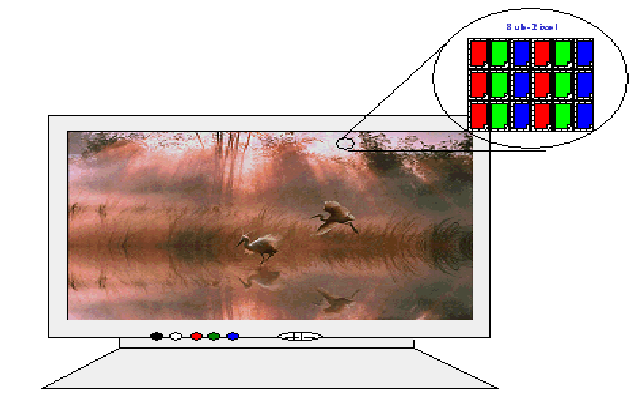
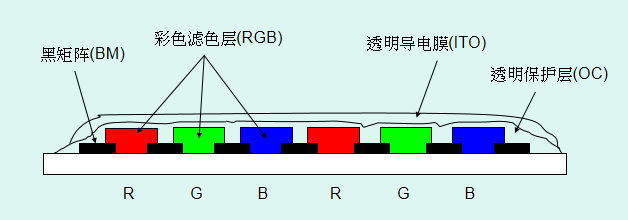
Color filter film
Each pixel of the color filter film corresponds to each pixel of the LCD screen, and each pixel contains three sub-pixels: red, green and blue. The light passes through the color filter film to form three primary color components: red, green and blue, as shown in the figure above.
Tft-lcd circuit control principle
The main function of TFT-LCD circuit is to control the voltage value of the two surfaces of the liquid crystal to control the deflection Angle of the liquid crystal, change the torsion Angle of the liquid crystal molecule to the linear polarized light, and through the orientation of the front polarizer, and finally control the strength of the light. The thin film field effect transistor (TFT) corresponds to each sub-pixel controlled, and the TFT is a switching device whose on-off and cutoff states are close to ideal switches. Taking a display with a resolution of 1024×768 pixels as an example, each pixel consists of sub-pixels of R, G, and B three primary colors, that is, a total of 1024×768×3 TFT transistors. As shown in the following picture
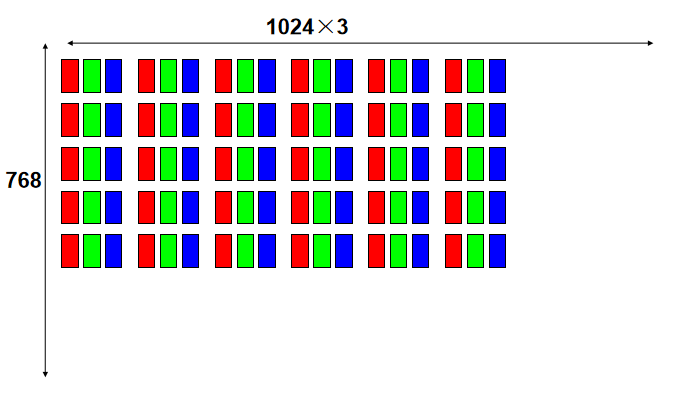
1024 x 768 resolution pixels
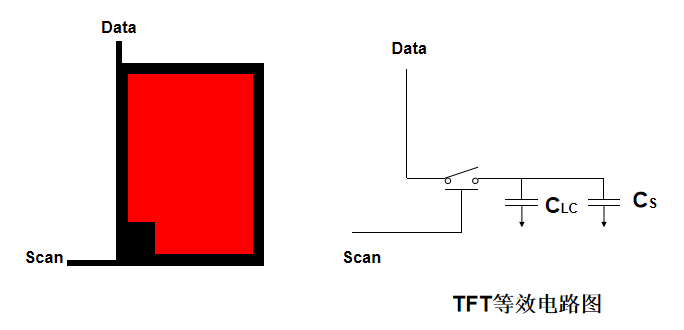
A sub-pixel control circuit
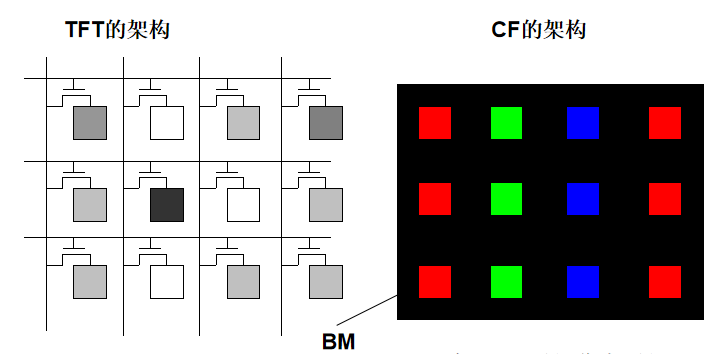
Transistor control architecture
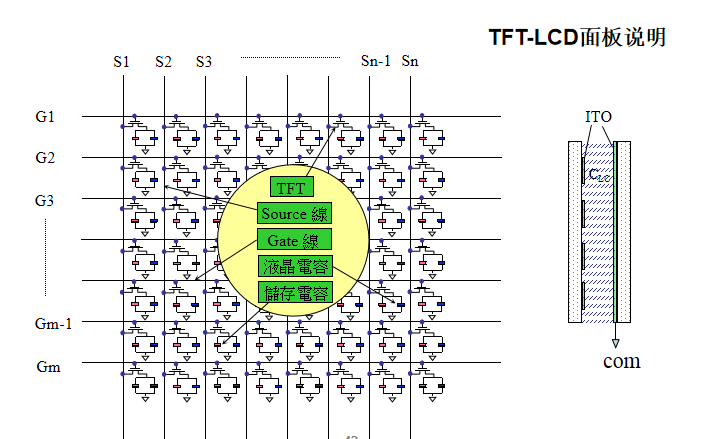
Transistor control architecture
The gate line has 768, and the source line has 1024×3. The control circuit adopts the method of time-sharing drive, and sets the gate line high level respectively in order to control the opening of the TFT transistor, and the voltage on the source line is added to the sub-pixels of the liquid crystal in the row, so as to control the deflection Angle of the liquid crystal in the row and finally realize the control of the transmittance of the light.
Tft-lcd display principle
Taking the LCD screen of 1024×768 pixels as an example, the backlight behind the LCD board projects a pure white light source, and the light source passes through the first polarizer in the direction of a, filtered into the biased aurora in the direction of A, through the transparent electrode (TFT control circuit), through the liquid crystal, then the liquid crystal molecular deflection Angle and transmission are controlled by the TFT control circuit, after passing the liquid crystal, After the color filter, the formation of 1024×768×3 beam of RGB primary color light controlled by the deflection direction, and then through the second b direction of the polarizer, the deflection direction of each beam of RGB primary color light filtered into the strength of the controlled RGB primary color light, projected on the screen. By changing the voltage value of the driving liquid crystal, the light intensity and color of the final appearance can be controlled, and then the color combination of different shades can be changed on the liquid crystal panel.
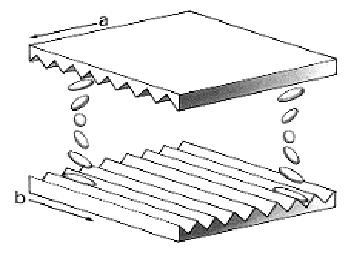
The polarized light direction of the upper and lower polarizer is perpendicular to each other
Color LCD display features
Viewing Angle
LCD has the weakness of anisotropy of viewing Angle and relatively small viewing Angle range, and wide viewing Angle technology has been an important research topic of liquid crystal technology. This is because when the incident light of the backlight passes through the polarizer! After the liquid crystal and the so-called oriented film, the output light has a specific directional property, that is, most of the light emitted from the screen has a vertical direction. That is, if you deviate from the normal direction of the display, the contrast is significantly reduced, watching an all-white picture, we may see black or color distortion.
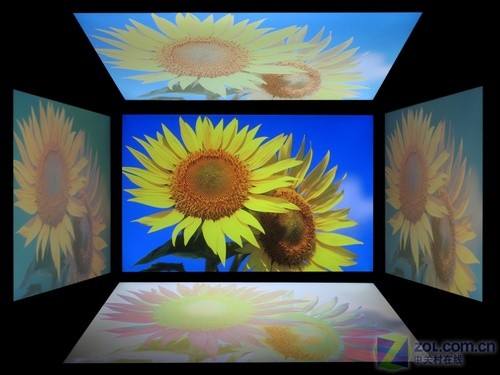
There are color differences at different angles
Response time
Slow response is a major drawback of liquid crystals. The response time of the liquid crystal display each pixel, the reaction speed after the signal input, is the time required for each point to turn from dark to light or from light to dark, the response time is of course the smaller the better. In this way, the user will not have the feeling of dragging the tail shadow when watching the moving picture. This indicator of the liquid crystal display directly affects the restoration of the dynamic picture, compared with other display methods, the liquid crystal display due to too long response time, resulting in a more obvious tailing phenomenon in the restoration of the dynamic picture, the picture is not vivid enough.
This is because the liquid crystal display uses liquid crystal molecular torsion to control the light on and off, and the liquid crystal molecular torsion requires a process, so the response time of the LCD display is significantly longer than other display methods. Especially in the small gray scale changes between all black and all white, a small voltage needs to be applied for accurate and fine Angle control, so the liquid crystal molecule torsion speed is slower.
Therefore, the screen refresh rate is also limited by liquid crystal materials, and now many mobile phone manufacturers have launched a lot of high-frequency refresh mobile phone screens, and the display animation is more delicate and smooth, and I believe that the future display technology will be more diversified and bring us a better experience.
* Source Web articles Scientific view of the world


